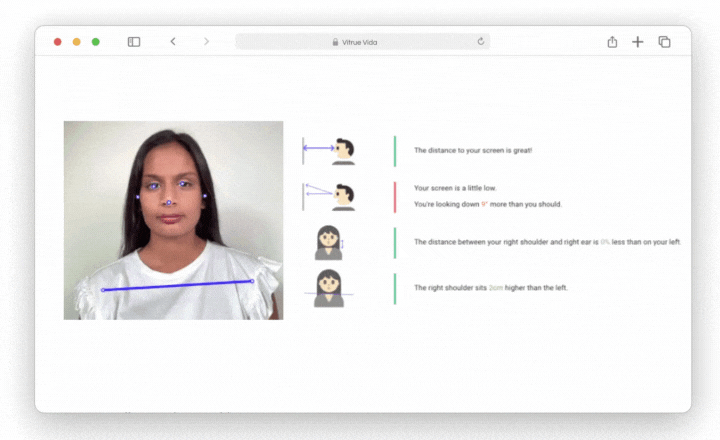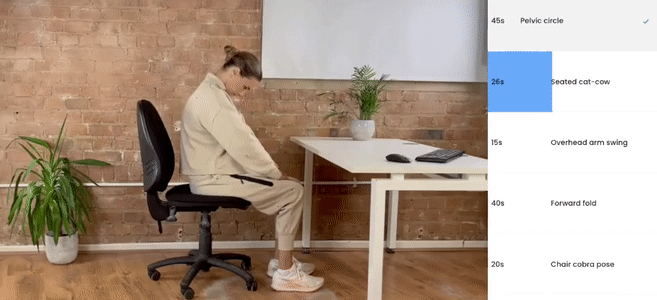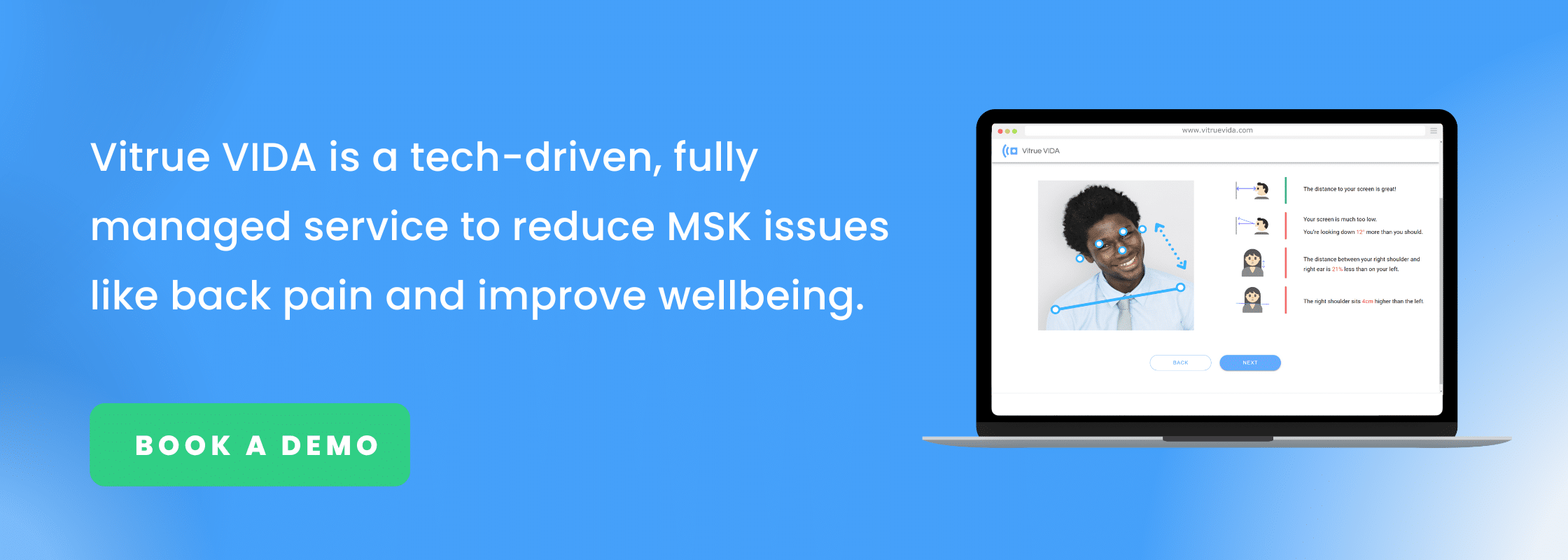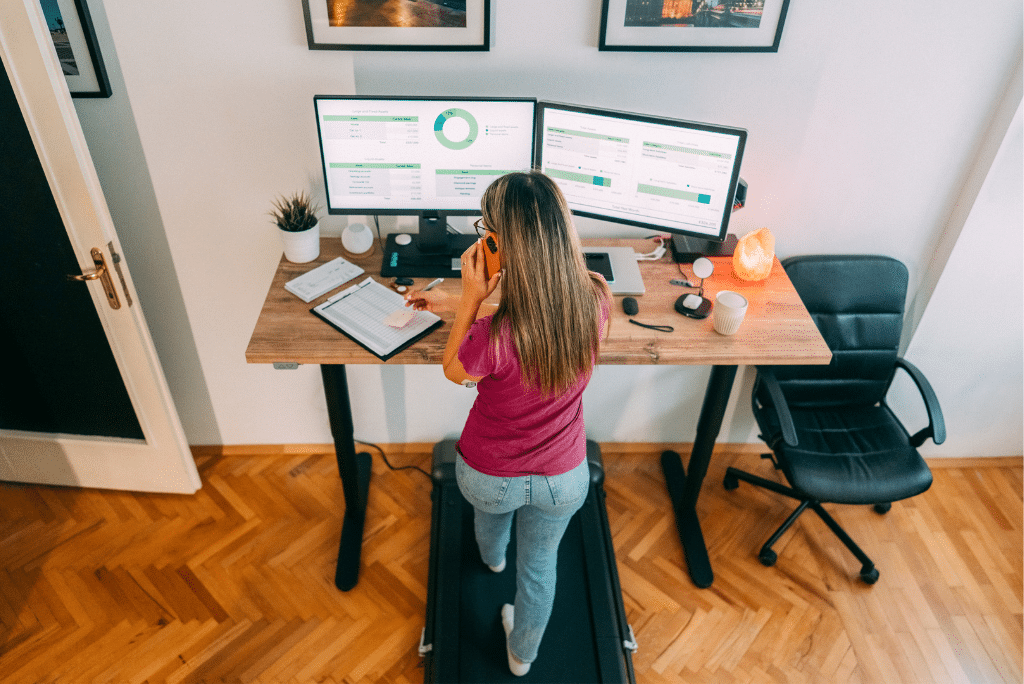In today’s hybrid working world, around 82% of all workers spend the majority of their working day seated. For desk workers, this is often 9 hours or more. The modern workplace culture of slouching in front of a computer for hours, combined with unhealthy working habits like sitting for long periods without breaks, has led to a population of desk workers with musculoskeletal (MSK) issues like neck, back, wrist and shoulder pain.
Under the Health and Safety (Display Screen Equipment) Regulations 1992, employers have an obligation to carry out DSE assessments to ensure their team have safe working environments in line with specific guidelines. However, companies often treat this requirement as a tick box exercise, focused solely on providing ergonomic equipment for their team. Many employers spend thousands on the latest ergonomic equipment such as standing desks, kneeling chairs and wrist rests. Others issue generous budgets for employees to purchase equipment of their choice, racking up hefty bills and placing significant administrative burden on their health and safety teams.
With 62% of desk-based employees reporting some level of MSK pain, this old-school approach to DSE compliance is clearly not working. Let’s explore why ergonomic equipment alone won’t solve desk-related pain and how to improve your team’s health and wellbeing without your equipment bill shooting up.
Did you know? 400,000 more people are now on long-term sick leave due to issues like back and neck pain compared to before the pandemic.
Why ergonomic equipment is just one part of the solution for desk-related pain
Ergonomic equipment is an important aspect of workplace health and safety, but desk-related pain isn’t just about the desk. Every employee has their own unique risk factors for developing pain, from their lifestyle to their posture and working habits.
For example, an employee with back pain may think they need a more supportive chair, but their injury actually stems from playing golf at the weekend. Keen runners are at an increased risk of knee pain. Parents with small children are more likely to develop pain from constantly bending down to pick up their kids. People with depression or poor mental health usually find it harder to motivate themselves to exercise, which can ultimately lead to pain.
Even the best ergonomic equipment can’t eliminate these wider MSK health risks which have a huge impact on workplace wellbeing. That’s why a holistic and personalised approach is needed to tackle work-related pain in your company.

What are the most common causes of pain in desk workers?
The human body is an incredible machine that is strong enough to lift a piano, precise enough to thread a needle, with such endurance over long distances it can outrun a horse. However, most people use their body for a purpose that it is fundamentally not designed to do – sitting at a desk for 9 hours a day or longer. Like any complex machine, when you use your body’s musculoskeletal system incorrectly, it breaks and causes issues over time.
Pain is complex and multidimensional. Your working setup, routine, posture, lifestyle and a myriad of other factors all play a part in whether or not you develop issues like back pain.
Here are some of the most common causes of pain in desk workers:
1. Poor posture
Poor posture is the number one cause of MSK issues like back pain amongst desk workers. Sitting in the same position for long periods of time whilst slouching or leaning forward can put extra stress on your spine, back and neck, leading to pain and stiffness. Tilting your head forward significantly can place up to 60 pounds of weight on your neck. That’s the average weight of a 9 year old child!
Consistent poor posture can have far-reaching consequences on many other aspects of your health and wellbeing, including poor circulation, headaches and digestive issues.
2. Repetitive tasks
Most desk workers perform repetitive tasks like typing or using a mouse, which can lead to repetitive strain injuries and the overuse of particular muscles and joints. Over time, this can lead to conditions like carpal tunnel syndrome and tendonitis.
3. Incorrect workplace ergonomics
28% of employees have major MSK health risks in their workplace, making them far more susceptible to issues like back pain. A much higher percentage of employees, around 70%, don’t know basic ergonomic principles like how to adjust their screen to reduce neck strain.
Working at a computer screen positioned too high or low, sitting on a chair without back support or reaching too far for your mouse or keyboard can strain your muscles and cause pain over time. Ergonomic factors such as limited space, noise, poor lighting and temperature can also contribute to stress and discomfort.
4. Poor working habits
Your working routine and habits are key dimensions of your overall wellbeing. The sedentary lifestyle associated with desk work is often at odds with the habits we need for a healthy life, such as frequent breaks and fresh air. Sitting for long periods without taking breaks is a recipe for stiff joints and muscles, poor circulation and pain.
5. Mental health
Physical pain and mental health are deeply interconnected. Employees with pain are four times more likely to develop mental health problems like depression and anxiety. For people with chronic pain lasting more than three months, the numbers are even more startling – 54% develop anxiety and up to 85% develop depression. The connection between pain and mental health has a significant impact on workplace health and factors like staff absence, productivity and retention.

How VIDA can reduce desk-related pain in your team
Every employee experiences pain differently. The most effective holistic wellbeing strategies include a personalised assessment of each employee’s risks and needs, with tailored strategies to support their physical health at work.
Vitrue Health’s online platform VIDA uses a clinical, holistic approach to prevent, treat and reduce desk-related pain. It takes your ergonomics, posture and habits into account, creating a deep model of pain in the context of your life.
VIDA has many features to help you reduce MSK issues like back pain in your team:
1. AI posture assessment and interactive workspace planner
Small ergonomic adjustments are often all it takes to eliminate workplace physical health risks. Raising your screen to the correct height only takes a few seconds, but it can reduce your risk of developing neck pain by 3x!
With VIDA’s AI webcam assessment and interactive desk planner, your team can assess their workspace in minutes and get instant personalised recommendations to improve their posture and workplace ergonomics.

2. Tailored pain management programmes
Physical activity is one of the most beneficial things you can do to keep your mind and body healthy. However, when it comes to pain and injury, a personalised approach is needed for employees to adopt the right stretches and exercises for their individual needs.
Pain Coach in VIDA is a fully personalised pain management programme tailored to individual needs. The digital platform provides a suite of targeted stretching exercises to help employees reduce pain. Pain Coach also contains an online library of educational videos and articles. These resources are personalised to your needs, to help you understand your specific pain area and learn about your path to recovery.

3. Personalised working habits recommendations
We already mentioned how your overall working routine and habits have a big impact on your overall health and wellbeing. Things like the frequency and duration of your breaks, how often you exercise and whether you have lunch away from your desk. Even the clutter in your workspace can make a huge difference – leaning across your desk all day to avoid piles of paper creates an imbalance in your back muscles, which may develop into pain over time.
VIDA provides personalised recommendations to improve your team’s overall wellbeing. It offers simple and effective things you can do to adopt healthier habits at work, all based in the scientific principles of workplace health.

At Vitrue Health, we’re on a mission to reduce musculoskeletal pain for millions of people. For more information on how VIDA can reduce pain in your team, get in touch with us at sales@vitruehealth.com or book a demo today!





